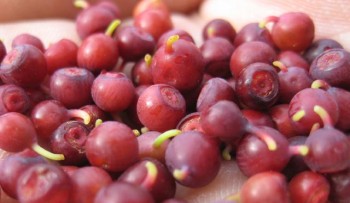
The high country huckleberry season (Vaccinium species) is winding down now, but it was such a success at its peak that I feel obliged to write about it. This is because not only did we find the berries plentiful (and literally in our very own back yard at 11,000 feet in the Colorado Rockies), but also because Gregg used them to make what was quite possibly the best wild edible dish I’ve had yet to date.
Colorado Huckleberries
I ate huckleberries last fall in New Hampshire that looked and tasted very much like blueberries, but the local huckleberries near Fairplay, Colorado are very different. When plentiful in mid-August, our back yard berries were translucent and ruby red, dangling like tiny gems from the lush, green, low-lying plants that carpet the forested areas behind our house. I tentatively identified them as grouse whortleberries (V. scoparium), which I read about in Wild Berries of the West by Betty B. Derig and Margaret C. Fuller. Even as of yesterday there were a few ripe patches out there, although the remaining berries seem to be purpler. (Whether that means the reds eventually turn purple or the purples ripen later I couldn’t tell you. Suffice it to say that the fruits range from red to blue-purple in color.)
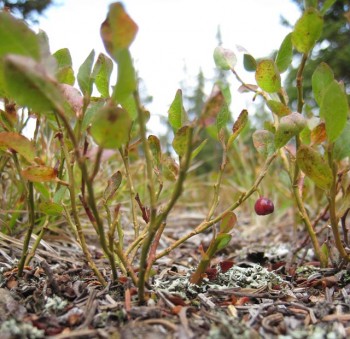
I first became aware of the local huckleberries after reading Cattail Bob Seebeck’s excellent guide, Best-Tasting Wild Plants of Colorado and the Rockies. “This is my favorite wild berry,” he writes, “the crème de la crème of wild berries.” I have to say I agree!
Inconspicuous Ground Cover
Last fall, after studying Cattail Bob’s photos of four stages of the plant’s growth cycle, I arrived at the tentative conclusion that any low-lying, inconspicuous ground-cover plant in a coniferous forest in the Rockies is likely to be either kinnikinnik (the leaves of which were dried by native people for smoking) or huckleberries. Kinnikinnik leaves are oval and leathery, whereas leaves of the local huckleberries have tiny teeth around them, so telling them apart is pretty straightforward. I quickly arrived at the conclusion that we had huckleberries around the house—oceans of them, in fact—just seemingly without berries.
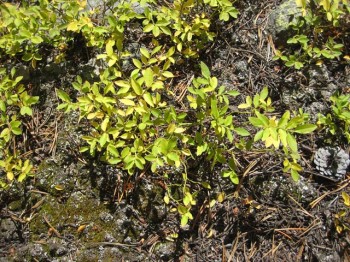
So this year we watched the suspected huckleberries. They flowered over the summer, sporting small, red-tinged hanging white urns, but we almost missed the fruits again this fall when a new-found interest in mushroom-hunting eclipsed all other thoughts of wild edibles. And then, lo and behold, we stumbled upon the huckleberry bounty by accident, down at foot-level on the forest floor, where they shielded some of the newly coveted mushrooms.
The huckleberries hang under the leaves of the plant, making them easy to overlook. Also, patches seem to ripen at different times, so if one patch isn’t fruiting, there still might be huckleberries in the next patch. We found the easiest way to harvest them was on hands and knees, but I won’t lie—it was hard work. In two hours, we two humans gathered about 2.5 cups of the tiny berries.
Any painful recollections of those hours we might have had, however, we quickly abandoned over dessert that night. This is because Gregg put together an absolutely epic culinary masterpiece—a wonderful, tiny, huckleberry crisp—which is why I am finally putting this blog entry together even though many of the berries are now past their prime.
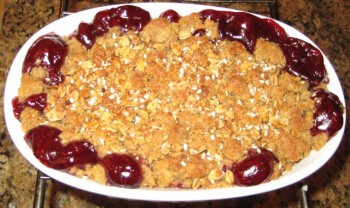
Gregg’s Huckleberry Crisp “Vir Vas”
My Polish grandmother likes to make batches of pies for the extended family, and whenever there is extra dough and filling at the end of one of her pie-making sprees, she makes a tiny pie in a tiny baking dish that she calls a “vir vas” (pronounced vid vas). I always imagined it was Polish for “small pie,” but I called and asked her and she laughed and admitted that she’s not sure where the name came from—Babci always used to call them by that name, but there’s a chance she made it up. Whatever the origin, when Gregg and I make a tiny pie or apple or other-fruit crisp, we like to call it a vir vas, too.
Since two and a half cups of berries makes a fairly small desert (just enough to feed two foragers for two nights at a sensible serving size) Gregg used a small baking dish the size of my hand for the purpose. The result was a wild huckleberry crisp vir vas to die for.
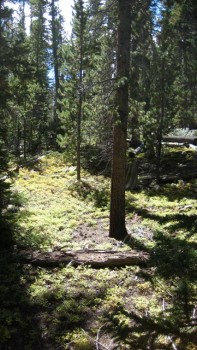
Gregg’s dessert is actually a bastardization of two recipes—the topping from my grandmother’s apple crisp, and a pie filling recipe from which cookbook we cannot for the life of us remember. For the filling, instead of just laying the fruit in the baking dish (which is what I would have done), Gregg simmered the 2.5 cups of huckleberries in water and added cornstarch to thicken along with some sugar. Then he put the fruit mixture in the dish and layered in the crisp—½ cup flour plus ½ cup brown sugar mixed with ¼ cup of melted butter and some fresh granola (our special ingredient) over top. He then baked the vir vas at 350 degrees for 40 minutes (it would be like 25 minutes at lower altitudes), let it cool for 20 minutes, and served it with ice cream, to my infinitesimal delight.
I highly recommend experimenting with wild a huckleberry crisp vir vas yourself if you get the chance!

I have a friend in Evergreen, CO – not sure how far that is from you – but just turned him on to huckleberries (from Idaho, where I am) this year and he is in love with them now. My daughter and I just picked 9 gallons about a week ago and are still processing them into jams and such. I enjoyed your blog article (is that what it’s called?) but don’t know really what RSS feeds are so will stop here from time to time to check out what you have to say. Again, thanks!
Cheryl, aka Hklbrries 🙂
Kinnikinnik’s red berries are good, too, IF they get enough water and not too much sun. They do have a hard seed to spit out. Same for Oregon Graperoot’s blue berries.
Yeah I nibble the kinnikinnik but have yet to find a good culinary use so if you have one, please by all means share! I like the Oregon grape berries for sure too… Good to hear from you.
Thanks so much for the post. And the explanation of the diff between kinnikinnick and Vaccinium types Huckleberries. I have been trying to get an ID on the bushes here in the Santa Cruz mountains, CA, that are coming back as I pull the ubiquitous invasive Scotch Broom. But mine are now 4 ft high! Off the follow the Wild Berry book link now.
I live in Denver and was wondering if you are close enough to drive and come and purchase some huckleberries, or is there a place in Denver that sells them?
Hi, sorry for the late response. No local vendors that I know of for our wild huckleberries. If you are ever on a road trip to the Pacific Northwest, however, you can find them.
Hi – I’m a transplant from NE Washington to Colorado near Denver. I *crave* huckleberries. Do you know of somebody or a small group, within drivable distance from Denver, I could hook up with to go huckleberrying this year? Growing up, we had gallons of them every end-of-summer. – as did the neighbors and friends. Mom made them into pies and jam mostly. She also froze some. — When she moved out of her apt to a senior living place, she had a couple of frozen huckleberry packages in her refrigerator’s freezer. She gave them to me so I intended to make a pie. I put them in *my* freezer and forgot them (how could I do that?!). Several years later I saw them and decided then and there to make a pie. I made it according to Mom’s recipe and it was mouth-watering good. I thought the berries would be freezer burned or no taste or something but they were still wonderful. They also still stained clothes and towels just as well as when they were fresh! (ha!)